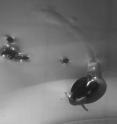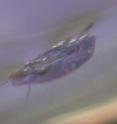Ripple effect: Water snails offer new propulsion possibilities
Related images
(click to enlarge)
A UC San Diego engineer has revealed a new mode of propulsion based on how water snails create ripples of slime to crawl upside down beneath the surface. Eric Lauga, an assistant professor of mechanical and aerospace engineering at the Jacobs School of Engineering, recently published a paper in the journal Physics of Fluid called "Crawling Beneath the Free Surface: Water Snail Locomotion," that explains how and why water snails can drag themselves across a fluid surface that they can't even grip.
Based on Lauga's research, the secret is in the slime. The main finding of Lauga's research is that soft surfaces, such as the free surface of a pond or a lake, can be distorted by applying forces; these distortions can be exploited (by an animal, or in the lab) to generate propulsive forces and move. Some freshwater and marine snails crawl by "hanging" from the water surface while secreting a trail of mucus. The snail's foot wrinkles into little rippling waves, which produces corresponding waves in the mucus layer that it secretes between the foot and the air.
Lauga and his team demonstrate that water snails have to distort the surface in order to move. "If they don't, they won't go anywhere," said Lauga, who explained that these water snails naturally rise up due to their low weight, and therefore do not have to work to remain near the surface.
Lauga and his colleagues said their finding could lead to a new method of propulsion. One of Lauga's colleagues, Anette Hosoi of the Massachusetts Institute of Technology, has already imitated the adhesive/ lubricating propulsive method of land snails to drive a robotic device. Now, as a result of this new water snail finding, the researchers said it may be possible to build similar devices that walk on water.
"The water snails show us that this is possible, and therefore one can design biomimetic systems taking advantage of that movement," Lauga says.
An example of a biomimetic system that could be designed based on Lauga's water snail research, he said, is small robotic swimmers, which could crawl underneath the free surface in a coordinated fashion. This type of technology, Lauga said, could be used for a number of small scale applications, such as aquatic military uses.
"The military is always looking for new ways to navigate and control displacements," he said.
The mechanism of terrestrial snail locomotion has been investigated over the past couple of decades, but the propulsion of water snails that crawl beneath a free surface hasn't been researched as extensively until now.
"This is interesting from a pure biological standpoint because it helps us understand Mother Nature," Lauga said.
'Bionic' Nature
Biomimetics is the application of biological methods and systems found in nature that could be used to design engineering systems and modern technology. Proponents of bionic technology believe that the transfer of technology between life forms and synthetic constructs is attractive because evolutionary pressure typically forces living organisms to become highly optimized and efficient. Therefore, they contend, designing engineering methods or tools that mimic such biological functions could be extremely efficient.
Examples of biomimetics in engineering include the hulls of boats imitating the thick skin of dolphins, as well as sonar, radar and medical imaging imitating the echolocation of bats. (Echolation involes emitting sound waves and listening to the echo in order to locate objects or to navigate).
For Lauga, his recent water snail research is a prime example of how engineers often look to nature's wide variety of locomotion strategies to inspire new inventions and robotic devices.
"Anything we can learn about biology and the way biological systems move and how particular biological systems generate forces is interesting," he said. "On a fundamental level we have to understand the world we live in."
Lauga, who specializes in fluid mechanics, said he will continue to use engineering techniques and methods to help unlock some of biology's most interesting mysteries.
"If you look at the best engineering departments in the country, many researchers are working to identify new problems and ask new questions in order to improve our understanding of how biological systems work," he said.
Source: University of California - San Diego
Other sources
- Ripple Effect: Water Snails Offer New Propulsion Possibilitiesfrom Science DailyThu, 9 Oct 2008, 21:21:18 UTC
- Ripple effect: Water snails offer new propulsion possibilitiesfrom PhysorgThu, 9 Oct 2008, 18:21:23 UTC


